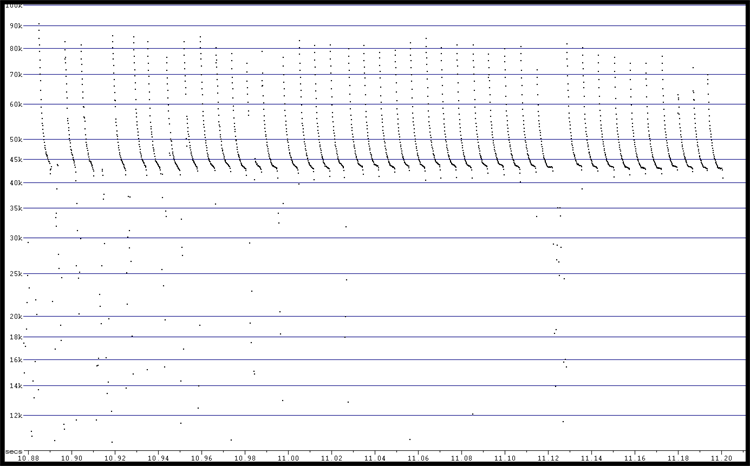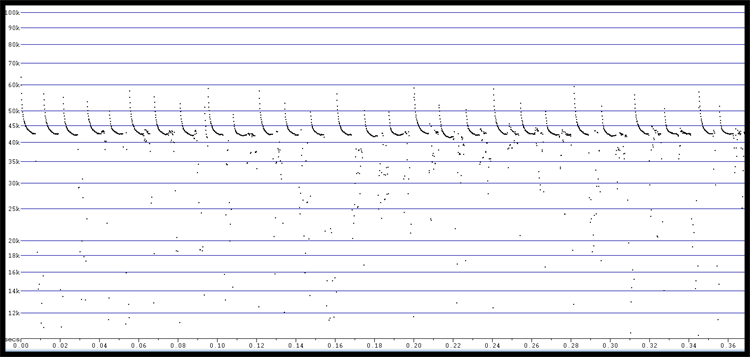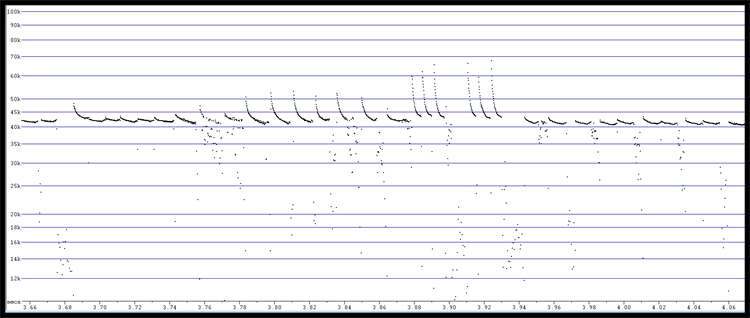Vespertilionidae
Guide for Acoustic Identification of Florida bats
Persub or Pesu
See glossary for explanation of codes
Perimyotis subflavus (F. Cuvier, 1832).
Taxonomy follows Simmons and Cirranello (2021)
To view call graphics click on the camera icon on the right. You can then move through all images by using the left or right arrow keys. A left mouse click returns to the fact sheet.
Typical North American Vespertilionid pulses with FM reversed J broadband pulses of short duration. However, call shapes vary depending on what the bat is doing when recorded. Pulses range from steep FM broad-band pulses of short duration to longer duration pulses with a pronounced rounding of the lower part of the pulse. Several examples are provided.
| Parameters | N | Min | Max | Mean | St.Dev | 10% | 25% | 75% | 90% |
| Dur | 2704 | 3.00 | 9.98 | 6.13 | 1.44 | 4.03 | 5.10 | 7.15 | 7.87 |
| TBC | 2634 | 48.9 | 4573.7 | 187.3 | 258.1 | 88.2 | 99.8 | 195.2 | 301.5 |
| Fmin | 2704 | 33.76 | 45.71 | 41.36 | 1.48 | 39.60 | 40.61 | 42.33 | 43.24 |
| Fmax | 2704 | 43.01 | 76.92 | 56.67 | 8.46 | 47.34 | 50.00 | 62.62 | 69.57 |
| BW | 2704 | 0.76 | 39.66 | 15.31 | 8.81 | 5.54 | 8.50 | 21.55 | 28.97 |
| Fmean | 2704 | 41.52 | 49.46 | 44.69 | 1.78 | 42.53 | 43.35 | 45.78 | 47.31 |
| Fk | 2704 | 40.20 | 47.90 | 43.69 | 1.43 | 42.11 | 42.55 | 44.69 | 45.71 |
| FcH1 | 2704 | 20.52 | 23.26 | 21.31 | 0.53 | 20.62 | 20.94 | 21.62 | 22.10 |
| Fc | 2704 | 41.03 | 46.51 | 42.63 | 1.06 | 41.24 | 41.88 | 43.24 | 44.20 |
| FcH3 | 2704 | 61.55 | 69.77 | 63.94 | 1.59 | 61.86 | 62.82 | 64.86 | 66.30 |
| Sc | 2704 | -234.09 | 326.64 | 15.22 | 24.68 | 0.00 | 5.12 | 21.36 | 41.81 |
| Pmc | 2704 | 0.60 | 87.50 | 32.93 | 19.42 | 11.30 | 17.90 | 46.50 | 64.00 |
Reported by Szewczak (2018)
| Persub | Fc | Fmax | Fmin | FmaxE | dur | uppr slp | lwr slp | slp @ Fc | total slp |
| Mean | 42.6 | 57.6 | 41.3 | 43.9 | 7.1 | 7.7 | 1.1 | 0.2 | 2.5 |
| Max | 44.0 | 67.0 | 43.0 | 46.0 | 8.4 | 14.0 | 1.7 | 0.7 | 4.0 |
| Min | 41.0 | 48.0 | 40.0 | 42.0 | 5.8 | 1.7 | 0.4 | -0.4 | 0.9 |
Cynthia and George Marks
Reference calls recorded by Marks and Miller are being archived at BioAcoustica and will be freely available. See Baker et al., (2015).
|
|
As Pipistrellus subflavus; Least concern; Ver.3.1 ; Population trend - stable; evaluated . (I.U.C.N. 2017.)
See Baker et. al., (2015) for discussion of BioAcoustica and Baker and Vincent (2019) for a critique of the lack of freely available acoustic data.
Baker, E., B. W. Price, S. D. Rycroft, J. Hill, and V. S. Smith. 2015. BioAcoustica: a free and open repository and analysis platform for bioacoustics. Database. 2015. bav054
Baker, E., and S. Vincent. 2019. A deafening silence: a lack of data and reproducibility in published bioacoustics research? Biodiversity Data Journal 7: e36783.
Marks, C. S., and G. E. Marks. 2006. Bats of Florida. Pp. 176. University of Florida Press, Gainesville.
Simmons, N. B., and A. L. Cirranello. 2020. Bat Species of the World: A taxonomic and geographic database. http://batnames.org
Szewczak, J. M. 2018. Echolocation Call Characteristics of Eastern U.S. Bats. Echolocation call characteristics of Eastern U.S. Bats. Unpublished report.
The IUCN 2017. Red List of Threatened Species. Version 2017-1.www.iucnredlist.org;. Downloaded on August 6, 2017.








